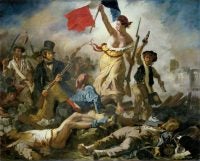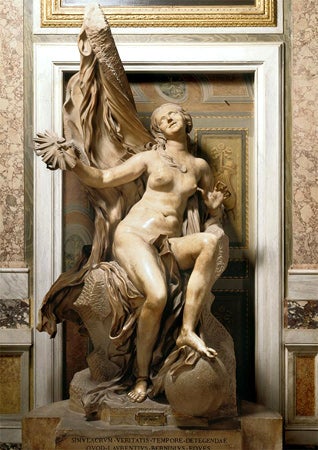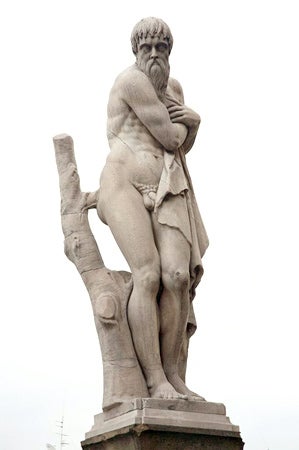By Lera Boroditsky, Assistant Professor of Psychology at Stanford University
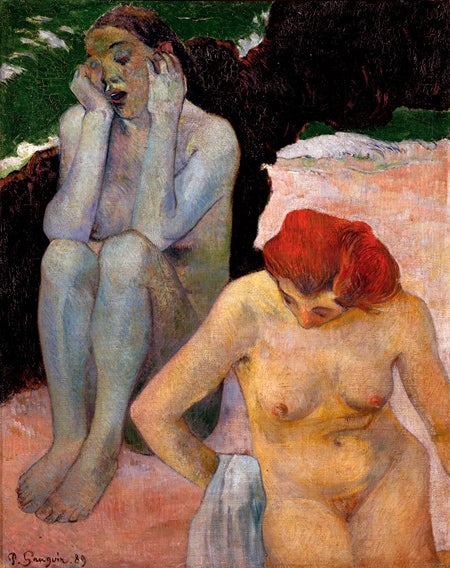
How do artists decide whether time, death, or liberty should be personified as male or female? One suggestion comes from linguistics. For example, Roman Jakobson (1959) reports: “The Russian painter Repin was baffled as to why Sin had been depicted as a woman by German artists: he did not realize that ‘sin’ is feminine in German (die Sünde), but masculine in Russian (грех).” Does the grammatical gender of nouns in an artist’s native language indeed predict the gender of personifications in art?
To answer this question, we measured the correspondence between grammatical gender and personified gender in Artstor. We started with all works of art contained in the Artstor Digital Library, and selected all images from 1200 AD to present day that were indexed by the keywords “personification” or “allegory” originating from Italy, France, Germany, and Spain (where the languages spoken have grammatical gender, and for which a large-enough sample of artworks existed in the database). The images were screened for usability and categorized by gender by a naïve coder, not familiar with the grammatical genders of nouns in the languages of interest.

Our results show a clear correspondence between grammatical gender in language and personified gender in art. Overall, the depicted gender matched the grammatical gender in 78% of the cases, significantly more often than if the two factors were independent, χ2(1, N = 765) = 172.7, p < 0.00001; odds-ratio = 9.33. Grammatically feminine entities were more likely to be personified as female (86% female, 14% male), and grammatically masculine entities were more likely to be personified as male (40% female, 60% male). Details and many further analyses are available in the full paper published in Frontiers of Psychology.
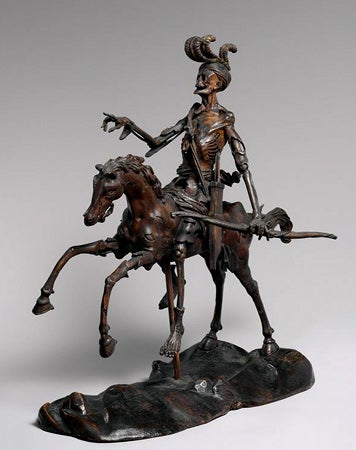
Of course, grammatical gender is only one of the forces that may influence an artist’s decisions in personification. Take the example of Alfred Kubin, a Czech-born and Austrian-educated expressionist whose drawing “The best physician” portrays death as a woman. Kubin’s mother died when he was 10, he attempted to commit suicide on her grave at 19, and a few years later suffered a nervous breakdown after the death of his fiancé. It is quite clear that the grammatical gender of “death” in Czech (feminine) or German (masculine) would not have been the only source of influence in forming Kubin’s conception of death. Considering how many different forces can exert influence on an individual’s conceptualization of abstract entities like love and death, it seems especially striking that grammatical gender – a small quirk of grammar – can be used to predict the gender of personification 78% of the time.
Of course, artists do not produce their work in a historical vacuum. For many allegorical themes there are strong precedents from history, mythology, and cultural tradition that can shape the artist’s choice in personification. We do find, however, that even for uncommon allegories (geometry, necessity, silence) where less historical precedent is available, there is still a strong correspondence with grammatical gender. In a correlational analysis like this it is not possible to establish whether grammatical gender in language helped create the extra-linguistic cultural patterns we observe or whether the influence went the other way, or both. It seems likely that linguistic and extra-linguistic aspects of culture act in concert and mutually reinforce each other, in many reciprocal cycles of causation over time. Structures in language may influence artistic decisions, and in turn patterns in artistic tradition may encourage, enrich, or help reify structures in language, and so on.
Our analysis demonstrates a close coupling between grammatical structures in language and other aspects of culture. It appears that patterns in language may not only be reflected in our private mental lives, but may also become reified in the material world we create around us.
Learn more about Lera Boroditsky’s work on a January 2018 episode of NPR’s Hidden Brain, a podcast about unconscious patterns that drive human behavior.
